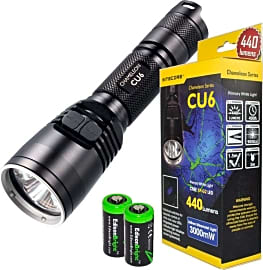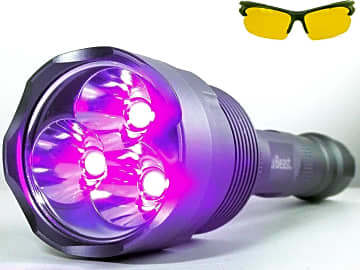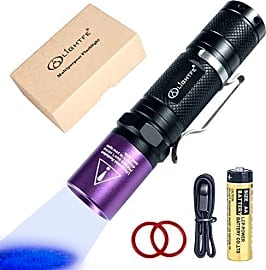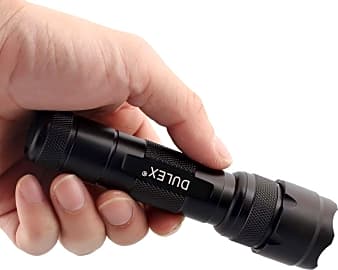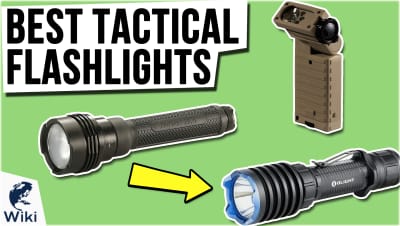The 7 Best UV Flashlights

This wiki has been updated 37 times since it was first published in April of 2016. Whether you travel to exotic and potentially unhygienic locations, or you have a pet that likes to soil your carpets when you're not looking, owning a high-quality UV flashlight can help you discover all kinds of new and unpleasant things — what you do with them afterwards is up to you. Also, since scorpions and some other pests glow in blacklight, these make great bug hunting tools. When users buy our independently chosen editorial selections, we may earn commissions to help fund the Wiki.
Editor's Notes
June 25, 2021:
We removed a handful of no-name models from questionable brands, and consulted some dedicated UV flashlight enthusiasts to find the experts' picks. The results of our search include the Convoy C8+, which is about the best performer you'll find. It even offers an extension tube, so you can use two batteries at once and greatly increase its duty cycle. We also really like the Weltool M2, partly because you can choose from focused and even-beam versions. At the other end of the spectrum, the Dulex DX-502B is still our favorite low-cost option from a reliable manufacturer.
December 30, 2019:
UV flashlights can be used to detect counterfeit currencies or IDs, find bodily fluids, determine mineral content in rocks, spot fluorescent dye leaks, and more. For those looking for a well-built model that can withstand the rigors of daily high-volume or field use, or for anyone who is rough on their tools, we recommend the Streamlight Stylus Pro, Jaxman U1 Mini, Nitecore CU6 Chameleon, UVBeast V3, and LightFE UV301D, which are all built very tough. Of these, the Streamlight Stylus Pro and LightFE UV301D are best if you will be keeping them in a toolbox or anywhere else where they may get mixed up with other flashlights, since they both have purple bezels that makes them easy to differentiate from traditional units. We also like the Nitecore CU6 Chameleon because it eliminates the need to carry multiple flashlights, since it has red, green, blue, and white LEDs. However, the UVBeast V3 might just have the strongest beam out of all of the models on our list. It is marketed as having an 80-foot beam throw, but there are many user claims of it projecting significantly further than that, so if that is important to you, it might be your best option.
The average home user who may only periodically have need for a UV light when they are hunting for the source of an odor in their home or scouring their yard for scorpions can probably easily get by with one of the more economical options on our list. The TaoTronics TT-FL002, McDoer 100 LED, Dulex DX-502B, LEDwholesalers 7202UV395, and Escolite Detector are all reasonably priced and found to be reliable enough for most consumer's needs. Of these, the Dulex DX-502B and TaoTronics TT-FL002 seem to produce the highest fluorescence in bodily fluids, and the former even includes a pair of yellow glasses to further boost contrast between the detected fluid and whatever surface it is on.
Of all the models on our list, the LightFE UV301D is the only one suitable for detecting minerals in rocks, since it outputs a 365-nm wavelength, as compared to the roughly 395-nm wavelength of the others.
A Bright Idea: Getting a UV Flashlight
When choosing a UV light, consider where you will store the device.
An ultraviolet flashlight puts the power to control a unique portion of the light spectrum right in your hand. UV light itself is invisible to the naked human eye, but is nonetheless quite helpful in illuminating many substances thanks to the unique luminescent properties it creates when reflected by everything from gemstones to the bodies of certain insects.
These lights are not expensive tools, and most UV flashlights are also of relatively small size. Both the small cost and size of these devices is principally thanks to recent advances in LED technology, which allows for the efficient production of potent ultraviolet light.
When choosing a UV light, consider where you will store the device. Some options can easily tuck into a glove box or even a pocket, while others are large enough to require a bit more room, though still stowing easily in a bag. Next consider how and where you will use the light. Some units have single bulbs or several small LEDs and are fine for use when they can be held close to the surface in question, while others use larger batteries of bulbs to cast a beam across much more distance. Also consider the power source of your prospective UV light; some such flashlights partner a USB cable and rechargeable battery, while others burn through traditional batteries quickly.
What a UV flashlight will not do, it must be noted, is provide any significant illumination such as one would expect from a standard flashlight. Ultraviolet light cannot be effectively used to find your way down a dark path or about a dark room, nor can this type of light be effective in signaling to someone across a distance.
Also, keep in mind that despite the fact that UV light cannot be seen, it is far from innocuous. Indeed ultraviolet light can be quite dangerous, with excessive exposure to the UV rays from the sun causing both acute and chronic issues (see below for more information) and with UV light able to damage the human eye even with limited direct exposure. You must never look directly into the beam of a UV flashlight, and you should in fact consider wearing UV protective glasses that are tinted to reduce the potency of the light and protect your eyes from damage.
Uses For a UV Flashlight
When many people hear of a UV flashlight, their first thoughts may well be of its less-than-pleasant applications. Indeed these tools can be used to attempt to identify substances such as human bodily fluids left behind on bedspreads in hotel rooms or on the carpets of a home in consideration for rental or purchase.
A UV light can instantly reveal evidence that might otherwise have been difficult if not impossible to uncover.
But ultraviolet lights also serve a critical role in various professions. The forensic investigator, for example, can use one of these lights to help search a crime scene for traces of blood or other liquids that can prove invaluable for identifying a perpetrator. A UV light can instantly reveal evidence that might otherwise have been difficult if not impossible to uncover.
So too can an inspection professional use UV light to search for leaks in various air conditioning, plumbing, or gas lines or to identify potentially unsafe substances in a home or commercial location. These lights aid in the conduction of inspections prior to a home sale, in the safety review of a worksite or production facility, and more.
Members of the general public will also find many handy applications for their ultraviolet light, with the most common use being to identify substances like pet urine in a carpet, antifreeze dripped onto the driveway or garage floor, and even for checking modern paper money to ensure they are not counterfeit.
And finally UV lights can simply be amusing to use. Ultraviolet light can help glow-in-the dark materials such as paints or pictures shine with ethereal luminescence, serving as ideal decorative tools for a party or as part of the special effects setup of a play or musical performance. Whether you are designing a haunted house for a Halloween event or you are in charge of the decorative scheme for a rave-style dance party, a UV flashlight is an affordable and effective way to enhance the aesthetics of the space.
What Is UV Light, Anyway?
Ultraviolet light is a normal part of the electromagnetic spectrum of natural light, or light that is produced by the sun. (It can also be produced by manmade devices, of course.) Sunlight is generally divided into seven distinct categories, each determined by the size of its wavelengths. These include, in order of decreasing wavelength size, radio waves, microwaves, infrared light, visible light, UV light, X-rays, and gamma rays.
Any portion of the radiation in the electromagnetic spectrum with a wavelength between ten and 400 nanometers is referred to as UV light.
Any portion of the radiation in the electromagnetic spectrum with a wavelength between ten and 400 nanometers is referred to as UV light. While invisible to the human eye, many animals can see ultraviolet light; these include certain insects, birds, and reptiles. While humans cannot directly perceive UV light, our eyes can see its interaction with certain materials in proper conditions where visible light is low. When concentrated UV light is absorbed and/or emitted by certain surfaces or substances, we call the effect fluorescence. This phenomena can be perceived as ultraviolet light shines on certain types of gem stones, a number of unique animal species, or on manmade artifacts such as posters, t-shirts, and decorative items.
With moderate exposure, UV light is relatively benign for human beings, causing a moderate darkening of the skin referred to as a tan. A glut of exposure can lead to acute painful damage in the form of a sunburn in the short term and can greatly contribute to larger chronic issues such as skin cancers. UV light is also the chief culprit behind faded flooring and upholstery, cracked and damaged dashboards in vehicles, and other types of degradation of many varieties.




